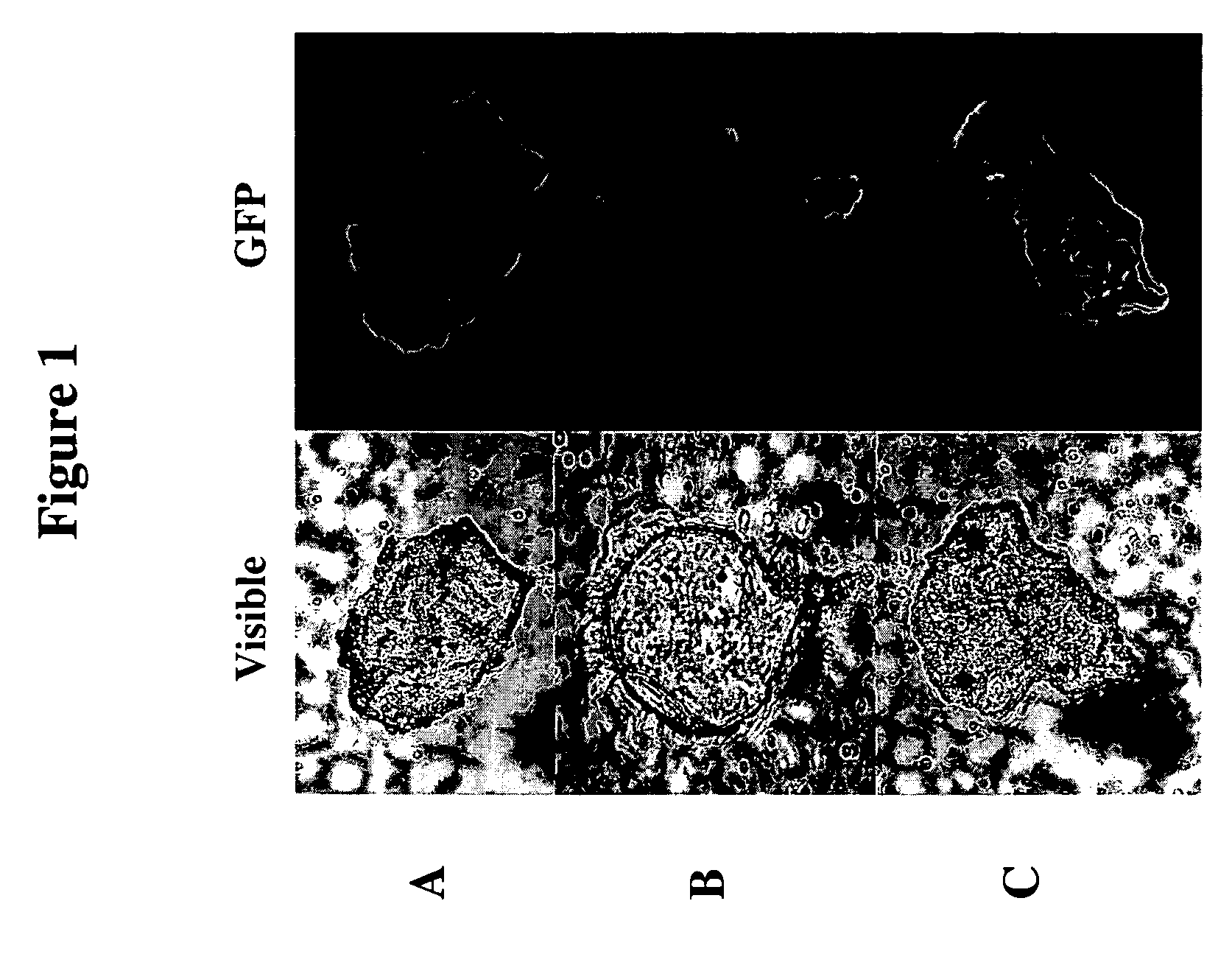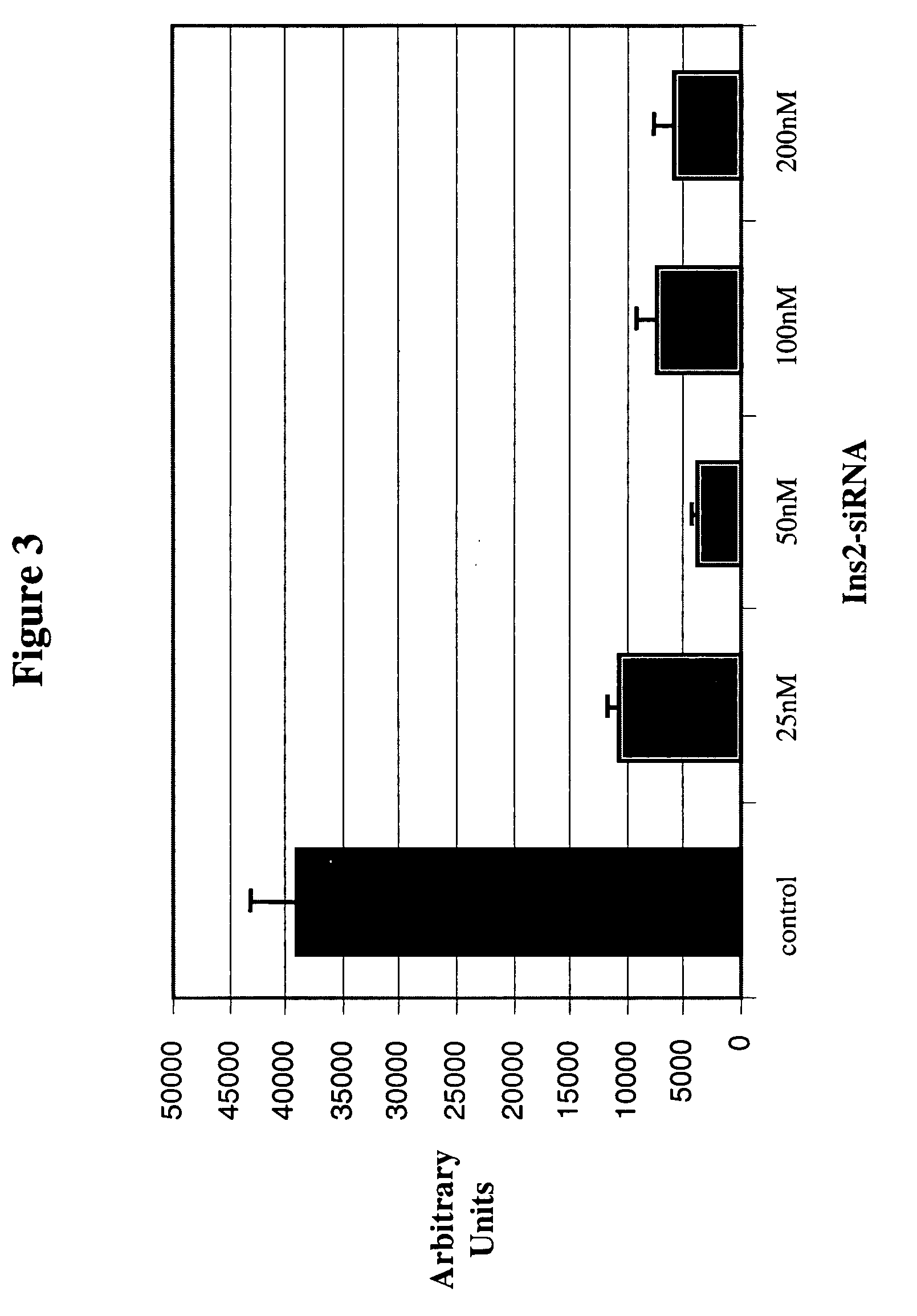Therapeutic alteration of transplantable tissues through in situ or ex vivo exposure to RNA interference molecules
a technology of rna interference and in situ exposure, which is applied in the direction of biocide, active genetic ingredients, genetic material ingredients, etc., can solve the problems of organ toxicity, destroy the function of the transplant, and destroy the foreign tissue, so as to prevent immune-mediated rejection of transplanted tissues, prevent growth or propagation, and prevent apoptosis-induced ischemic injury
- Summary
- Abstract
- Description
- Claims
- Application Information
AI Technical Summary
Benefits of technology
Problems solved by technology
Method used
Image
Examples
example i
Effective ex vivo Treatment of Isolated Islet Cells with siRNA
[0213] The efficacy of administration of siRNA to islet cells in culture was examined. Islet cells were isolated from C57B116 mice by methods previously described (Ricordi, C and Rastellini, C. Automation in Islet Isolation. In: Ricordi, C, ed. Methods in Cell Transplantation. Austin, Tex., USA: RG Landes Co. 1995; Salvalaggio PRO et al. Transplantation. 2002, 74:877-900), and these cells were employed to assess the ability of siRNA molecules directed against a green fluorescent protein (GFP) to downregulate production of GFP expressed from an exogenously introduced adenoviral vector (adeno-GFP). Successful cellular incorporation of the anti-GFP siRNA was anticipated to diminish green fluorescence of cultured islet cells. Three groups were used: 1) a negative control, wherein cells were administered no siRNA, 2) a non-specific siRNA control, and 3) siRNA directed to inhibit GFP (anti-GFP siRNA). Those islet cells transfe...
example ii
Effective Perfusion of Whole Pancreas in situ with siRNA
[0214] Given the efficacy observed for siRNA administration to cultured islet cells, studies were performed to examine the effect of siRNA perfusion to whole pancreas. Initial studies were conducted to test surgical procedures for siRNA injection into pancreas of BALB / c mice. siRNA was either injected as “naked” molecules or packaged into liposomes using Lipofectamine 2000 (Invitrogen). The control siRNA used was labeled with the red-fluorophore, Cy-3, to track the siRNA location in the tissue. 1 c.c. containing 2 μg siRNA / liposomes in UW (University of Wisconsin, Belzer Organ Preservation) solution +6% trypan blue was injected via retrograde portal vein. siRNA injections with naked siRNA resulted in poor diffusion into the tissue. After injections, pancreata were removed and stored at 4° C. for 20 hours. Organs were fixed in buffered formalin, paraffin embedded, and sections were stained for insulin with immunofluorescence. T...
example iii
Suppressed Insulin Production via Whole Pancreas siRNA Perfusion
[0215] Whole mouse pancreas was perfused (by the methods of the preceding Example) with anti-Insulin 2 siRNA (Ambion pre-designed siRNA ID #62419). Such experiments demonstrated the efficacy with which perfused RNAi agents were capable of suppressing production of a native transcript in a whole tissue. Following perfusion of whole pancreas with anti-Insulin 2 siRNA, islet cells were isolated using standard islet preparation procedures as described, e.g., in Jonas, J. C., et al. (Diabetes 1998 47, 1266-73). Isolated islet cells were then transferred to wells for performance of real-time RT-PCR. Each well contained 200 islet cells. Real-time RT-PCR was performed in triplicate on lysed cells using a FAM-labeled Insulin-specific TaqMan probe (Roche Molecular Systems, Inc.), with FAM fluorescence detected by an ABI 5700 machine. Islet cells isolated from whole mouse pancreas that had been perfused with varying concentration...
PUM
| Property | Measurement | Unit |
|---|---|---|
| pH | aaaaa | aaaaa |
| pH | aaaaa | aaaaa |
| Tm | aaaaa | aaaaa |
Abstract
Description
Claims
Application Information
 Login to View More
Login to View More - R&D
- Intellectual Property
- Life Sciences
- Materials
- Tech Scout
- Unparalleled Data Quality
- Higher Quality Content
- 60% Fewer Hallucinations
Browse by: Latest US Patents, China's latest patents, Technical Efficacy Thesaurus, Application Domain, Technology Topic, Popular Technical Reports.
© 2025 PatSnap. All rights reserved.Legal|Privacy policy|Modern Slavery Act Transparency Statement|Sitemap|About US| Contact US: help@patsnap.com



